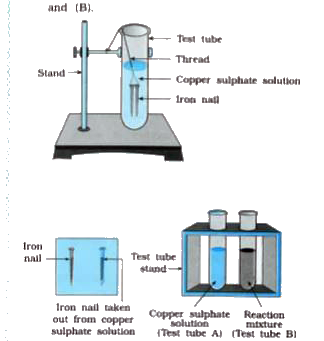Rinku took 10 mL each of two solutions A and B separately in two test tubes. The solutions were in copper sulphate and zinc sulphate respectively the colours of the two solutions wereSolution in Punjabi
A-pale green, B-colourless
A-blue, B-pale green
A-colourless, B-blue
A-blue, B-colourless
Step by step video & image solution for Rinku took 10 mL each of two solutions A and B separately in two test tubes. The solutions were in copper sulphate and zinc sulphate respectively the colours of the two solutions were by Chemistry experts to help you in doubts & scoring excellent marks in Class 10 exams.
Updated on:21/07/2023Topper's Solved these Questions
- METALS AND NON-METALSBOOK - MODERN PUBLICATIONCHAPTER - METALS AND NON-METALSEXERCISE - EXERCISE
429 Videos
- CHEMICAL REACTIONS AND EQUATIONSBOOK - MODERN PUBLICATIONCHAPTER - CHEMICAL REACTIONS AND EQUATIONSEXERCISE - EXERCISE
141 Videos
- PERIODIC CLASSIFICATION OF ELEMENTSBOOK - MODERN PUBLICATIONCHAPTER - PERIODIC CLASSIFICATION OF ELEMENTSEXERCISE - EXAMPLE
53 Videos
Similar Questions
List two metals which are easy to cut .
View SolutionTranslate the following statements into chemical equation and balance the equations : aluminium metal replaces iron from ferric oxide (Fe2O3) giving aluminium oxide and iron.
View SolutionA part of the periodic table is show below:

Which of these is/are noble gases?
View SolutionA student took four test tubes containing solutions of different colours marked I,II, III and IV as shown here. The test tubes containing copper sulphate solution and ferrous sulphate could be the tubes:

View SolutionAluminium sulphate and copper sulphate solutions were taken in two test tubes I and II respectively. Iron filings were then addd to both the solutions. The four students A,B, C and D recorded their observations in the form of a table as given on the next page. The correct set of observations have been recorded by the student:
View SolutionA student took four test tubes I,II,III and IV containing aluminium sulphate, copper sulphate, ferrous sulphate and zinc sulphate solutions respectively. He placed iron strips in each one of them. after some time he found a brown deposite formed in test -tube marked:

View SolutionIn a science fair , a student took two test tubes labelled A and B filled with copper sulphate solution, then he put magnesium ribbon in test tube A silver foil in tube B. Predict the observation and justify.
View SolutionAqueous solution of copper sulphate+ zinc dust → Aqueous solution of zinc sulphate + copper.
View SolutionTwo platinum electrodes were immersed in a solution of cupric sulphate and electric current passed through the solution. After some time it was found that the colour of copper sulphate disappeared with evolution of gas at the electrode. The colourless solution contains
View SolutionA student took four test tubes I, II, III and IV containing aluminium sulphate, copper sulphate, ferrous sulphate and zinc sulphate solutions, respectively. He placed an iron strip in each of them. In which test tube, a brown deposit is formed?
View SolutionAim : To study the displacement reaction taking place between iron nail and solution of copper sulphate.
Activity:
Take three iron nails and clean their surface by rubbing them with a sand paper.
Take two test tubes labelled as (A) and (B). Take about 10 mL solution of copper sulphate in each test tube.
Tie two iron nails with a thread and immerse them in copper sulphate solution for about 20 minutes.
Keep one iron nail aside for comparison.
Take out the iron nails from the copper sulphate solution after 20 minutes.
Compare the colour of both iron nails with the nail kept aside.
Compare the intensity of the colour of copper sulphate solutions of both the test tubes, (A) and (B).

What would be the change in colour of solution of copper sulphate ?
View SolutionAim : To study the displacement reaction taking place between iron nail and solution of copper sulphate.
Activity:
Take three iron nails and clean their surface by rubbing them with a sand paper.
Take two test tubes labelled as (A) and (B). Take about 10 mL solution of copper sulphate in each test tube.
Tie two iron nails with a thread and immerse them in copper sulphate solution for about 20 minutes.
Keep one iron nail aside for comparison.
Take out the iron nails from the copper sulphate solution after 20 minutes.
Compare the colour of both iron nails with the nail kept aside.
Compare the intensity of the colour of copper sulphate solutions of both the test tubes, (A) and (B).

Which reaction takes place when iron nail is dipped in the solution of copper sulphate ?
View SolutionAim : To study the displacement reaction taking place between iron nail and solution of copper sulphate.
Activity:
Take three iron nails and clean their surface by rubbing them with a sand paper.
Take two test tubes labelled as (A) and (B). Take about 10 mL solution of copper sulphate in each test tube.
Tie two iron nails with a thread and immerse them in copper sulphate solution for about 20 minutes.
Keep one iron nail aside for comparison.
Take out the iron nails from the copper sulphate solution after 20 minutes.
Compare the colour of both iron nails with the nail kept aside.
Compare the intensity of the colour of copper sulphate solutions of both the test tubes, (A) and (B).

What type of chemical reaction occur, when iron nail is dipped in copper sulphate solution ?
View SolutionThe colour of copper sulphate solution-
View SolutionA student took four test tubes I, II, III and IV containing aluminium sulphate, copper sulphate, ferrous sulphate and zinc sulphate solutions, respectively. He placed an iron strip in each of them. In which test tube, a brown deposit is formed?
View Solutionजस्ता कॉपर सल्फेट के विलयन से ताँबा को विस्थापित कर देता है, किन्तु ताँबा जिंक सल्फेट के विलयन से जस्ता को विस्थापित नहीं कर सकता, क्यों ?
View Solution
